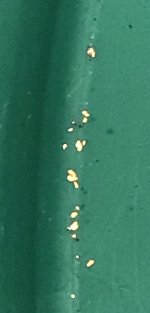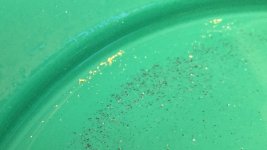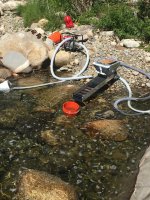matt_unique
Jr. Member
- Jul 16, 2014
- 97
- 63
- Primary Interest:
- All Treasure Hunting
Fellow gold hunters who have worked the Swift River - from a day of dredging on an entry level rig are you getting more than say 15-20 flakes of gold? I'll post some pictures below of my haul from a day of dredging but I've got a dredge/hibanker combo and thus far use just the dredge (2" nozzle on a 10K gph Honda water pump). I have 3-days of dredging on this rig but never get more than about 20 flakes of gold from a day.
I look for the inside curve of the river and/or large rock formations and/or bedrock. Basically anything that will slow down water and cause a dead zone where the heavies should drop. I look at the river like a giant sluice box - where is the gold likely to drop. With that being said, maybe I am just not picking the right spot. I set my rig up with a level, adjust engine power and drop angle until the sluice 'feels right' where the box is dropping most of the whites and keeping the red and black sand with some eddies behind the ridges causing the material to dance just a little. I have run for half a day and then panned some from the drop pile (did not find any gold).
If you are on scuba/hookah with a 4" nozzle of course you will get a lot more than what I could get with my 2" nozzle and arms reach down, but I welcome any advice. Am I just choosing the wrong spot to make a hole? Is arms reach not getting me to the best layers? Or is 15-20 flakes about all I can expect with my rig from the very popular Swift? I see the haul from many posters (though not usually from Maine - of course CA and other places are just on a different level of gold production) but wowee I'd love to find something a little more exciting.
A typical day:

My best haul (everything small but more than usual - back side of a bedrock layer):

My rig:

Thanks
--Matt
I look for the inside curve of the river and/or large rock formations and/or bedrock. Basically anything that will slow down water and cause a dead zone where the heavies should drop. I look at the river like a giant sluice box - where is the gold likely to drop. With that being said, maybe I am just not picking the right spot. I set my rig up with a level, adjust engine power and drop angle until the sluice 'feels right' where the box is dropping most of the whites and keeping the red and black sand with some eddies behind the ridges causing the material to dance just a little. I have run for half a day and then panned some from the drop pile (did not find any gold).
If you are on scuba/hookah with a 4" nozzle of course you will get a lot more than what I could get with my 2" nozzle and arms reach down, but I welcome any advice. Am I just choosing the wrong spot to make a hole? Is arms reach not getting me to the best layers? Or is 15-20 flakes about all I can expect with my rig from the very popular Swift? I see the haul from many posters (though not usually from Maine - of course CA and other places are just on a different level of gold production) but wowee I'd love to find something a little more exciting.
A typical day:

My best haul (everything small but more than usual - back side of a bedrock layer):

My rig:

Thanks
--Matt






